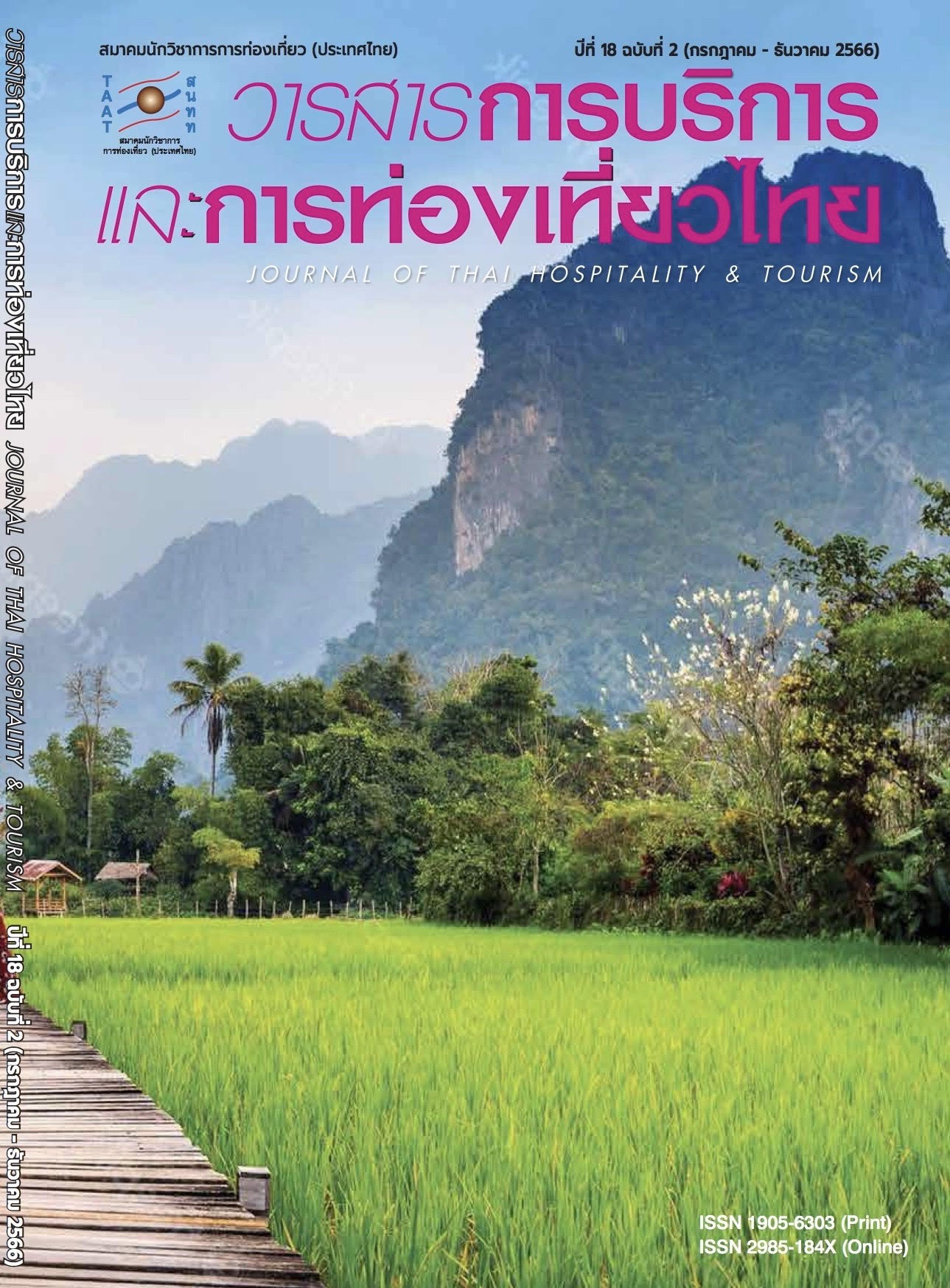การออกแบบเส้นทางการท่องเที่ยวเชิงสร้างสรรค์วิถีใหม่ ชุมชนพื้นที่ป่าฮาลาบาลา จังหวัดยะลา
Main Article Content
บทคัดย่อ
การศึกษานี้มีวัตถุประสงค์ 1) เพื่อวิเคราะห์ศักยภาพแหล่งท่องเที่ยวในพื้นที่ชุมชนพื้นที่ป่าในอำเภอธารโต และอำเภอเบตง จังหวัดยะลา 2) เพื่อออกแบบกิจกรรมการท่องเที่ยวเชิงสร้างสรรค์วิถีใหม่และพัฒนาเส้นทางท่องเที่ยวในชุมชนพื้นที่ป่าฮาลาบาลา จังหวัดยะลา และ 3) เพื่อประเมินกิจกรรมการท่องเที่ยวเชิงสร้างสรรค์วิถีใหม่ตามเส้นทางชุมชนพื้นที่ป่าฮาลาบาลา จังหวัดยะลา เป็นการวิจัยเชิงคุณภาพ ผู้ให้ข้อมูลหลักคือ ตัวแทนชุมชนหรือนักปราชญ์ชาวบ้านด้านแหล่งท่องเที่ยวในชุมชนรวมทั้งสิ้น 60 คน ใช้วิธีการเลือกแบบเจาะจง เครื่องมือที่ใช้ในการวิจัยคือแบบสนทนากลุ่ม โดยวิธีการสนทนากลุ่มและวิเคราะห์ข้อมูลโดยการพรรณนาวิเคราะห์
ผลการศึกษาพบว่า 1) จุดแข็งคือ หมู่บ้านคอมมิวนิสต์มาลายา สถานที่สำคัญทางประวัติศาสตร์ที่ควรค่าแก่การเรียนรู้ของคนยุคหลังมีกิจกรรมการท่องเที่ยวที่หลากหลาย เดินป่า ชมทะเลหมอก ล่องแพ เรียนรู้ประวัติศาสตร์ การแช่เท้าในน้ำสมุนไพร จุดอ่อนคือ ขาดการบริหารจัดการการท่องเที่ยวอย่างมีส่วนร่วม โอกาสคือ พฤติกรรมนักท่องเที่ยวที่เปลี่ยนแปลงต้องการเรียนรู้ความเป็นตัวตน และวัฒนธรรมระหว่างคนในชุมชน ชอบเป็นผู้ร่วมมากกว่าผู้เยี่ยมชม อุปสรรคคือ การบริการจัดการการท่องเที่ยวกระจุก ขาดการเชื่อมโยงเครือข่ายและพื้นที่ใกล้เคียง 2) เส้นทางการท่องเที่ยวเชิงสร้างสรรค์วิถีใหม่แบ่งออกเป็น 2 เส้นทางดังนี้ เส้นทางที่ 1 ชุมชนจุฬาภรณ์พัฒนา 99 ท่องเที่ยวเชิงสร้างสรรค์ ด้านวัฒนธรรม กิจกรรมการต้อนรับนักท่องเที่ยว ย้อนรอยฐานพรรคคอมมิวนิสต์มาลายา และเรียนรู้วิถีประมงพื้นบ้าน และเส้นทางที่ 2 ชุมชนอัยเยอร์เวง ท่องเที่ยวเชิงสร้างสรรค์ ด้านธรรมชาติ กิจกรรม Welcome Drink น้ำสมุนไพรท้องถิ่น เรียนรู้อุปกรณ์การดำรงชีวิตของกลุ่มชาติพันธุ์ เปิดประสบการณ์สัมผัสกาแฟสดและของอร่อย ข้าวหลามบาซูก้า และ 3) การประเมินกิจกรรมการท่องเที่ยวเชิงสร้างสรรค์ เสนอแนะในการจัดการด้านขยะ ด้านความปลอดภัย และปรับปรุงสาธารณูปโภคที่จำเป็นเพิ่มขึ้น ได้แก่ ถนน ป้ายบอกเส้นทาง ห้องน้ำ หน่วยรักษาความปลอดภัย และสัญญาณโทรศัพท์ ทั้งนี้อาจเป็นเพราะว่าทั้ง 2 ชุมชนมีศักยภาพที่โดดเด่นมีแหล่งท่องเที่ยวทางธรรมชาติและวิถีวัฒนธรรมที่หลากหลาย จึงเป็นจุดเด่นในการสร้างความประทับใจและความพึงพอใจของนักท่องเที่ยว
Article Details

อนุญาตภายใต้เงื่อนไข Creative Commons Attribution-NonCommercial-NoDerivatives 4.0 International License.
เอกสารอ้างอิง
Designated Areas for Sustainable Tourism Administration (DASTA). (2021). Creative Tourism. https://tis.dasta.or.th/stisdasta/creative-tourism
Greg, R. & Julie, W. (2007). Tourism Creativity and Development. Routledge.
Richards, G. & Raymond, C. (2000). Creative tourism ATLAS News B2 – ATLAS News. ATLAS.
Richards, G. (2010). Creative Tourism and Local Development. In Wurzburger, R. (ed.), Creative Tourism A Global Conservation How to Provide Unique Creative Experiences for Travelers Worldwide. Presented at the 2008 Santa Fe & Unesco International Conference on Creative Tourism in Santa Fe, New Mexico.
Thaveeseng, H. et al. (2020). The Potential of Creative Tourist Destination in Satun Province. Journal of Thai Hospitality and Tourism, 15(1), 3–16.
Thongwilai, B. (2016). Exploratory Factor Analysis of Travel Routes for Thai Tourists in Pranburi, Prachuab Khiri Khan Province. Bangkok University.
Wetkama, T. (2014). Creative Tourism for to Prepare Thai Tourism. Journal of Thai Hospitality and Tourism, 9(1), 64–77.
Wisudthiluck, S. et al. (2013). Creative Tourism. Designated Areas for Sustainable Tourism.


